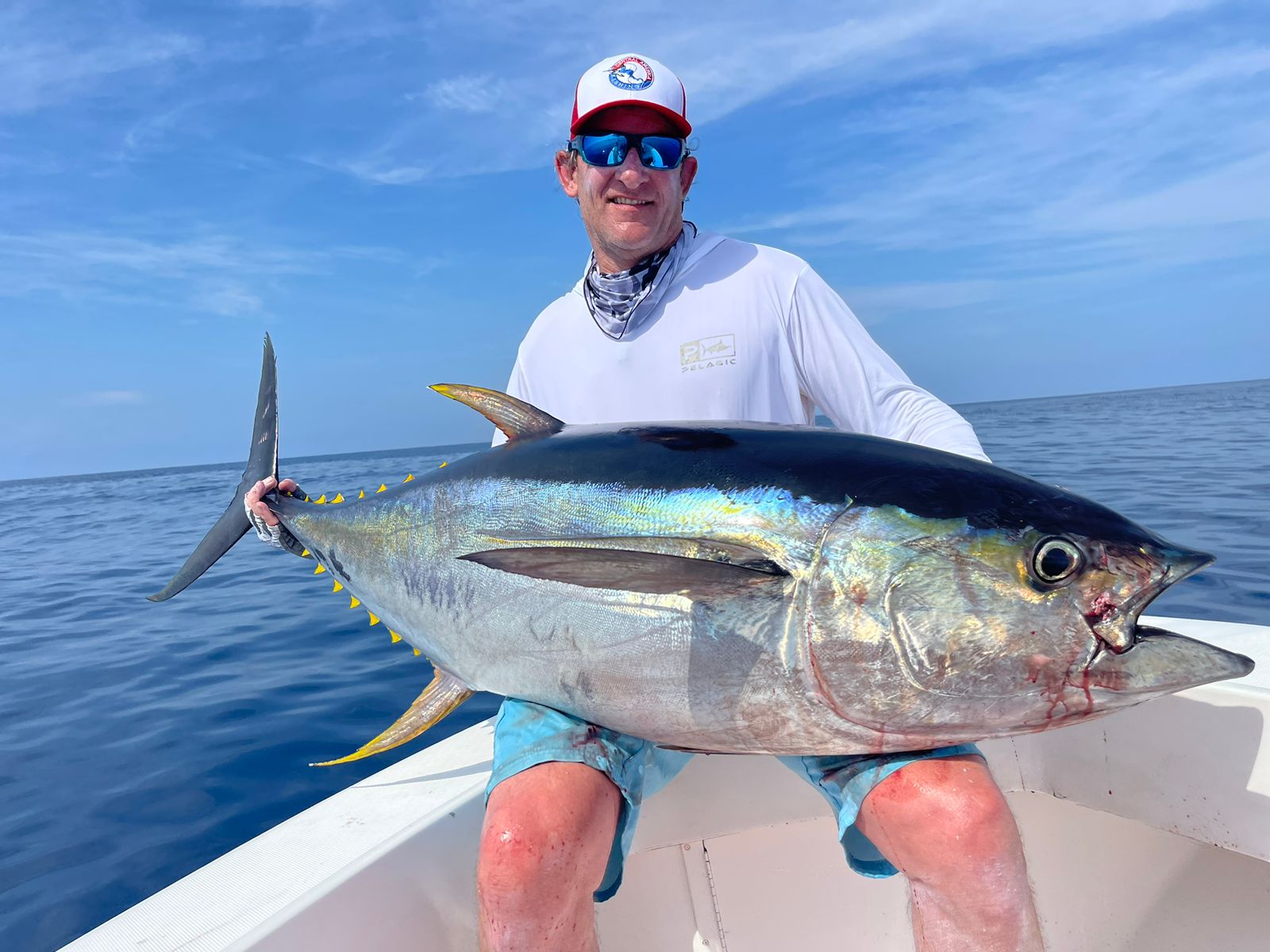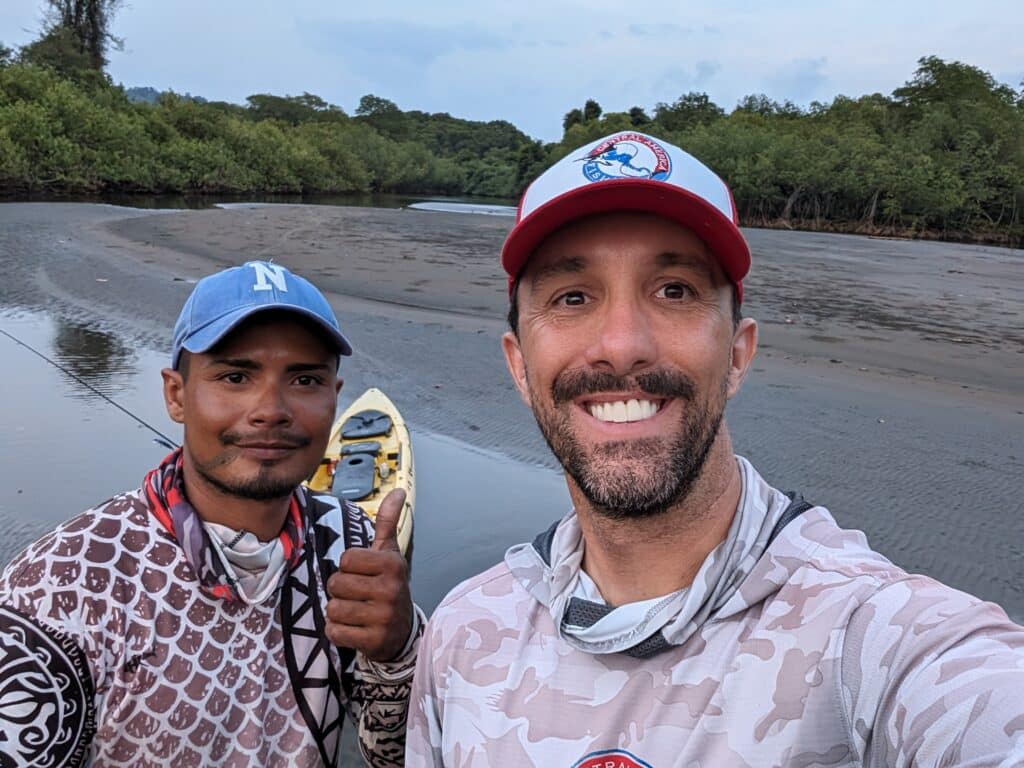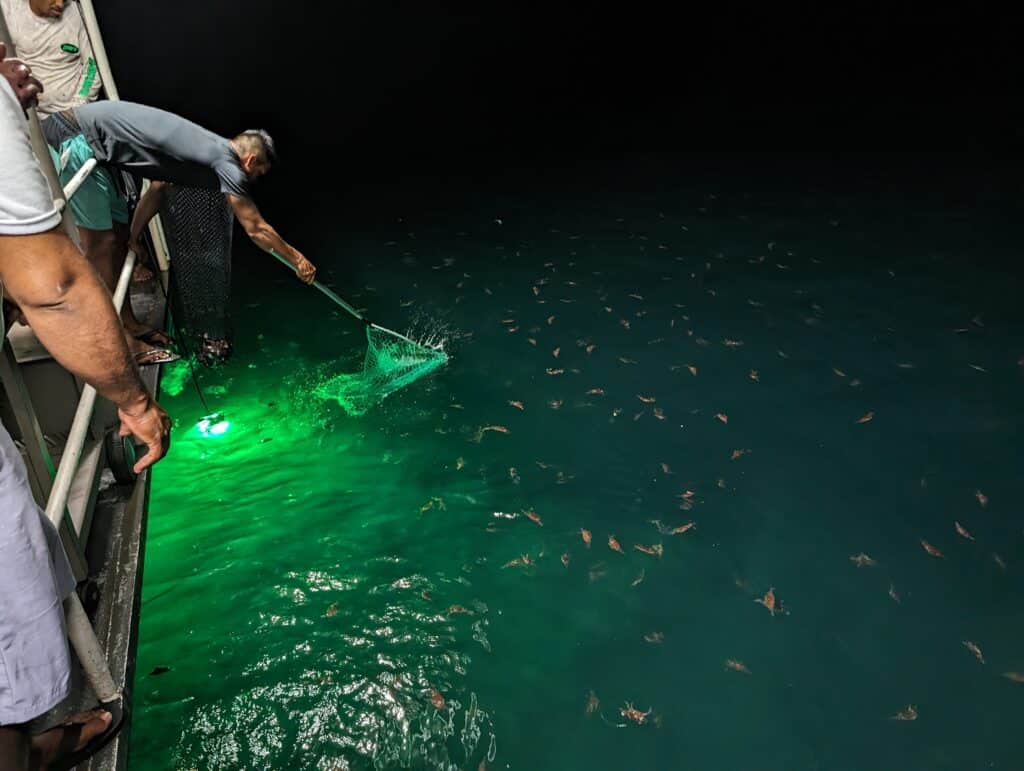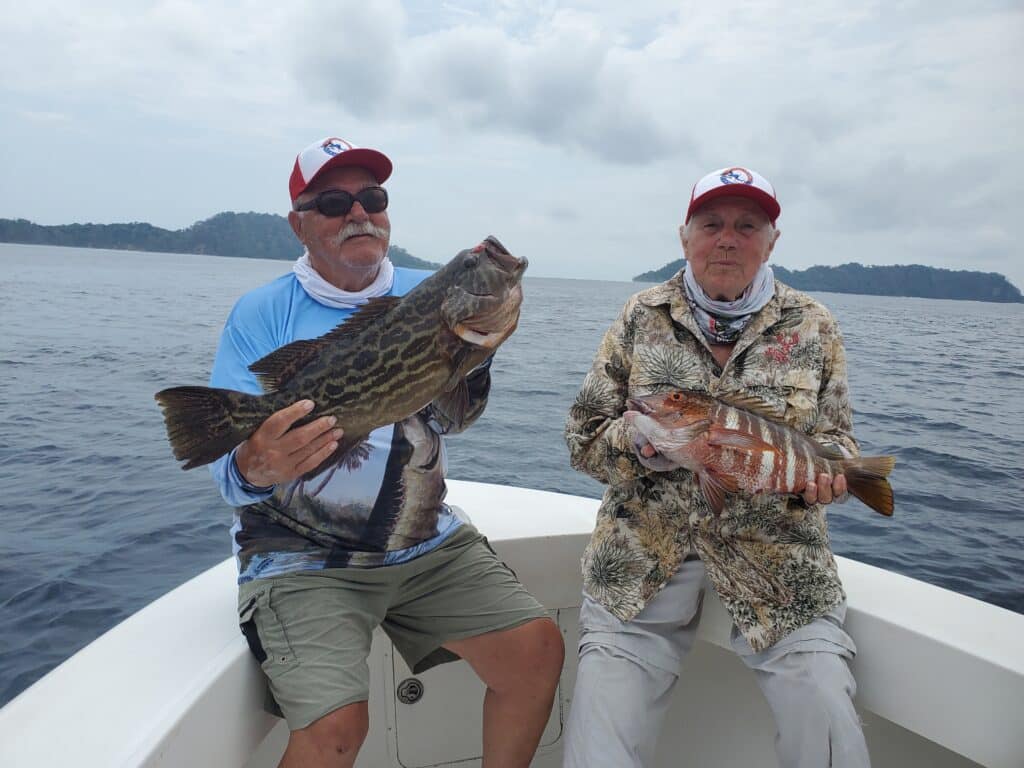I picked this week in late March based on the moon phase, low probability of strong north winds, and historical fishing patterns. March and April tend to be the peak sailfish months in Panama, and there is always a chance there are still marlin and dorado (mahi) around. It also marks the start of the peak yellowfin tuna season, so nearly all the pelagic game fish are in play. Inshore fishing, the coastlines have clear blue water so there is always consistent action for jacks, snappers, and roosterfish. The story of the week however is what I didn’t plan on – the absolutely incredible red crab hatch. This started the week prior to our arrival, so when I asked how the fishing was last week the usually reserved, seasoned captains responded with one-word answers of “incredible” and “unforgettable”. That says an awful lot coming from guys who fish these waters 30-34 weeks in a row each year, many of whom have been here for over a decade and a half.
As always, after arriving to the barge on Sunday evening, on Monday morning we started the week by running offshore to look for billfish and tuna. The week prior the tuna were all west of Isla Montousa, so that’s where we headed. The seas were so calm it was glossy for most of the ride, and it didn’t take us long to catch up to the commercial tuna boats that were headed to the same spot. An early highlight of the day was a small thresher shark going completely airborne about 30 ft off the starboard bow – you never know what you’ll see out here. Soon we started seeing birds working, and it became clear we were in the right place. For the rest of the morning the organized chaos ensued of the agile sport fishing boats running down schools of tuna when they’d start to feed at the surface while the long liners tried to set all their flags & hooks. Poppers simply weren’t working despite hours of trying, so soon we changed tactics and began casting live blue runners towards the back of the commercial boats and were able to hook into a few solid fish. Captain Hebert was the first to hook up as Shane boated a 100 lb monster before 9 AM. Don & Virginia fought a double hook up for about ten minutes, then one pulled the hook and I think Don was actually relieved that he didn’t have to fight it any longer. Virginia and mate Luis tag teamed the other one, and soon we had the gaff in a beautiful 80 lb tuna – which was Virginia’s first. Navas was the top boat of the day boating a 50, 80, and giant 180 lb tuna, a personal best for Scott. Ray, Tom, and Bill had the most chaotic day as they battled a 200+ lb tuna for nearly 2.5 hrs. The fight started with the fish getting tangled in the long lines, then later on the rod snapped. Legendary first mate Chichi held the 65 lb braid in his bare hands while Captain Tomas tied it to a new pole, and the fight was back on. These seasoned vets, who also do a lot of tuna fishing in their native New Jersey, admitted that they all passed the rod 3-4 times each as they battled the giant. They were able to see color on it several times, but ultimately it spit the hook and was able to swim free. They didn’t go home empty handed however as they did boat a fifty-pound tuna later in the day. All in a all, a good start as our group finished with six tuna and well over 100 lbs of meat to start our week. We checked the stomach contents of a few of the tuna we harvested, and sure enough, most of them had partially digested crabs in their bellies…
The next day I explained to everyone that Monday’s tuna action was just a primer, but the real magic of this trip is the incredible inshore fishing that Coiba Island offers. An outfitter for 20 yrs, I’m careful not to overhype our fisheries as I’ve seen enough to know that anything can happen. I don’t think it would have mattered how much I hyped up the inshore fishing however as Tuesday around the island was simply one of the best inshore fishing days I’ve ever witnessed. All ten anglers from four different boats came back to the barge in total awe of how many red crabs they saw and how many fish they caught. The crabs were so numerous that the mates were netting them, putting them on jigs, and by the time they reached the bottom they were getting bit already. Captain Jonathan and mate Luis brought Don & Virginia back to he barge early as they were ready to cool off in the air conditioning by 3 PM. I asked how it went, and they said they caught 9 cubera snappers, 7 rock snappers, 10 yellowtail snappers, silk snappers, and a couple of jacks. If Don & Virigina caught 30 fish and were back on the barge by 3 PM, I knew that the other boats fishing until 5 PM must have had absolutely epic days. I wasn’t wrong – each boat came back reporting anywhere from 20-40 fish ranging from amberjacks to cuberas to three or four different kinds of smaller snappers. Ron & Scott said they’ve never seen anything like it. Bill, who again has been doing this trip for 20 years, said it was easily one of the best fishing days he’s ever had in his life. Normally when I host our CAF weeks on the mothership I set a goal of 100 fish, but we did that on Tuesday alone. The fishing was so good, even barge captain Jaime and I racked up seven fish just dinking around the bay in the panga for a few hours (3 Sierra mackerels, 2 yellowtail snappers, and 2 jacks). The first fish I caught hit my soft plastic red crab jig – these fish were dialed in.
While the guests were out enjoying the time of their lives, I also had an amazing experience as I did something I’ve never done before – kayaked deep into the jungle on one of Coiba Island’s various rivers. One of my favorite members of the Pesca Panama team, first mate Luis, was more than eager to go with me so we took two kayaks off the top of the barge and headed to the beach. Admittedly, I was weary of from the start as I’ve heard a few stories about how the crocodiles in the estuaries don’t like visitors, and having personally seen how big they are while we fish in our snook hole, I didn’t want to find out firsthand. We took the kayaks over the beach and down into the estuary, but it was low tide, so the crystal-clear water was only 3-4 inches deep and we relaxed a bit. Wade fishing at first, we cast small Rapalas into the deep-water holes and were able to snag our first couple of mangrove snappers. We did that for a hundred yards, then the water got deeper so we decided it was time to use the kayaks. Casting towards the deep holes as we slowly moved upriver, we started to rack up more fish and bigger fish. A few of the larger 4-5 lb mangrove snappers, “manglateros” as they are called here, were strong enough to give us a little sleigh ride. While the mangrove snapper action was certainly entertaining, what we were really after were snook. We’ve caught plenty of snook from the boats at the end of a fishing day as they corral sardines along the beach by the river mouth, but Luis and I were trying to find the lion’s den. I landed a smaller five-pound snook, but the giants eluded us until one miscast that I had to shake out of a tree fell into the water, a huge back exploded out after it, and then it was gone. It wasn’t a bite, but it was proof that there were big snook in here.
That night after dinner, those of us who stayed up for a nightcap (or two or three) noticed a few of the red crabs swimming around the barge lights. It seemed they were now making their way into our bay, which has us all excited for Wednesday’s fishing. I like to fish from the barge at night before I sleep, but Captain Navas was in my usual spot at the back of the mothership standing on Jaime’s panga. It took me a second to realize that he was actually netting the free-swimming crabs and filling 5-gallon zip-locks bags with them. He filled five, one for each boat plus another one for Jaime and I in the panga, so we put them in freezer and went to bed knowing that we had bait in case the crabs disappeared. That was foolish thinking…
Wednesday the boats ran south towards Jicaron & Jicarita Islands, and on the way they found the crabs again and along with it, another epic day of inshore fishing. Every single boat was catching silk snapper, red snapper, yellowtail snapper, and a few medium-sized cubera snappers as long as they put a red crab on a jig. A few African pompano made an appearance, as did a few beautiful broomtail groupers today. A few boats got tired of that action and left to go cast poppers towards the rocks, and in doing so found hordes of revved up jack crevalle that seemed to hit every popper thrown. Scott and Ron boated 30 jacks themselves, and that was AFTER catching snappers for hours! The highlight today by far was Scott hooking a jack, having that eaten by a bull shark, and then not only hooking but fighting an estimated 300 lb bull shark boatside so the mates could cut the leader. The four boats today caught at least 150 fish total.
Back on the barge, everyone was eager to share their stories from the day. As fun as this week had already been, the real show was the insane numbers of red crabs that filled the bay the surrounded the mothership that night. Even the captains & mates, who have now spent two straight weeks fishing in these conditions, were having fun netting them at the back of the barge at night. There were so many you almost thought you could walk across them, but the knowledge of bull sharks that like to patrol beneath the barge killed any motivation to actually try it. Once again, we filled bags full of them and put them in the freezer so we’d have bait for days to come.
Thursday is always a decision day for the anglers – do they head back offshore to the Hannibal Bank and Isla Montousa in search of marlin & tuna, or do they stick inshore and fish the island north back to land? Three of the four boats decided to stick to the inshore fishing since it was so good, and they were rewarded with 20-30 jack crevalle per boat along with a few different snapper species thrown in the mix. The one boat that went offshore did so because the anglers said they simply couldn’t cast any more after three days of casting, hooking, and fighting fish, so trolling would be easier on their tired bodies. They didn’t have any luck with marlin or tuna however. What felt like sort of a “comedown” day after an epic Tuesday and Wednesday still resulted in another 100+ fish caught for the four boats. Jaime and I also managed to hook and fight a big 40 lb bull dorado from the second story of the barge as we drove it back to land, but it pulled the hook about 15 ft from the boat.
I love hosting trips on our Panama mothership as it allows me to finally put faces to names that I’ve been helping plan vacations for over the years. It’s also one of my favorite fisheries, as I don’t know any place on Earth that can consistently produce 20-30 species a week, even on slow weeks. But most of all, I love the opportunity to spend 5 days fifty miles offshore in one of Central America’s most pristine national parks as you truly never know what you will see out here. We’ve all seen too many dolphins to count, crocodiles, giant manta rays, battled sharks (on purpose or by accident), and some have been lucky enough to see whale sharks – but none of us present this week will ever forget the natural phenomenon of seeing hundreds of thousands of red crabs and the absolute feeding frenzy it created. While I wish this was some sort of annual even that could be planned around, I am just thankful that I got to experience it firsthand as this was truly a National Geographic moment. Our final tally for the week was:






















0 Comments